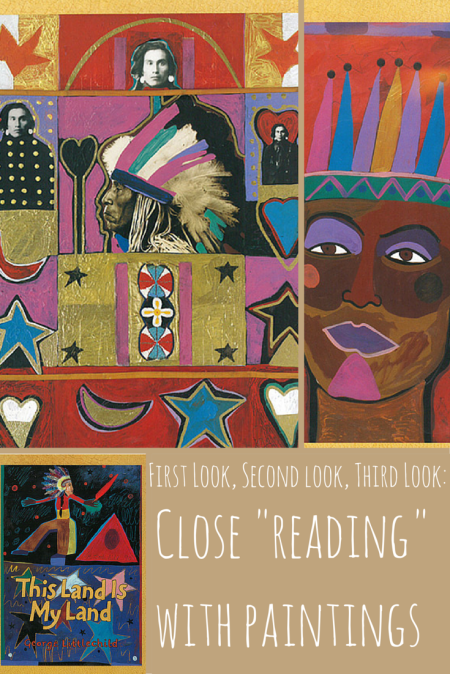I’ll admit it: I was looking for a Native American book by a Native American author to write about in light of Thanksgiving and National American Indian Heritage Month as many teachers do this time of year.
 This led me to reread and re-experience the Children’s Book Press treasure, This Land is My Land, by artist George Littlechild. As winner of the 1994 Jane Addams Picture Book Award and 1993 National Parenting Publications Gold Medal, This Land is My Land is a notable treat for students and readers of all ages.
This led me to reread and re-experience the Children’s Book Press treasure, This Land is My Land, by artist George Littlechild. As winner of the 1994 Jane Addams Picture Book Award and 1993 National Parenting Publications Gold Medal, This Land is My Land is a notable treat for students and readers of all ages.
The book features 17 of the artist’s mixed media paintings organized to portray Native American history in North America and Littlechild’s own heritage and childhood. As I studied Littlechild’s paintings and read his accompanying essays about each, I felt as if I were on a gallery walk with my own earbud connected to the artist.
Although this picture book would make a great counterpoint to many Thanksgiving books out there, This Land is My Land is valuable beyond the Thanksgiving-relevant content. It is a great example of how art is a powerful medium for critical thinking development and can be integrated into literacy instruction (not just the assigned art block a couple times a week).
So, what does close reading (or “looking?”) look like with art?
Like a text, a piece of art is another place for students to engage with multiple times and each time diving into another level of meaning and interpretation. Using art in the classroom relates to the reading standard 7 of the Common Core, Integration of Knowledge and Ideas. Additionally, many of these questions are questions we would use with students in the close reading of a text.
Below is an example of how students can progress with their observations and thinking. I separated levels of questions into three viewings based on level of complexity, but of course one could (and should) return to a worthwhile painting many, many times.
First look (literal comprehension/understanding)
- What is happening?
- What patterns do you see? What images, colors, and symbols do you see repeated or used most often in this painting or across paintings?
- What materials does Littlechild use?
- How does Littlechild use positive or negative space?
- How does Littlechild use the foreground and background?
- Who is the narrator?
- What are some common ideas or events portrayed in his artwork?
- What is the central idea of the painting? What is the central idea of the paintings taken altogether? What makes you think so?
Second look (higher level thinking/interpretation of meaning)
- What effect do repeated colors, images, patterns, or symbols have on his art and the central idea?
- What effect does a specific material, such as shells or sequins, have on his art and the central idea?
- What does “Indian” mean to Littlechild?
- How does Littlechild’s background (childhood, heritage, identity, family relationships) affect the subjects, themes, and materials of his paintings?
- What has Littlechild learned from his elders? What does he want viewers to learn from or think about events in the past and our heritages?
- What is the mood of one piece of the artwork or the collective body of artwork? What makes you think so? What colors, patterns, materials, or images does he use to convey mood?
- What is the purpose of his art? Why would Littlechild create this painting or assemble these paintings into a collection? Why talk about these events and his heritage and childhood at all?
- Who do you think is the intended audience of This Land is My Land? What might Littlechild want them to do with this narrative and perspective?
- How does Littlechild demonstrate pride in and appreciation for his heritage? How does he convey pain in Native American history? How does he convey the closeness of his community?
Third look (higher level thinking/analysis of artist’s craft/structure/methods)
- Why does Littlechild choose to start the book with a dedication to his ancestors and include their photographs?
- How is the collection of paintings organized? How does the chronological structure convey or confirm his central idea? How does this mixed media collection compare to a biography in book form?
- Why does Littlechild choose the title and painting for the book cover: This Land is My Land? He doesn’t like the song, “This land is your land, this land is my land,” or its meaning; so, why does it fit as the title and cover painting for the book? What does this choice tell us about the central idea of the book? What message does he want to convey to viewers?
- Why does Littlechild use photographs in the painting, instead of just drawing the figures? What effect do the photographs have on the story he is telling and on the painting itself? (Repeat this question for feathers, sequins, shells, and feathers)
- Why do you think the artist chooses to use the motif of stars? What do a “star” mean in this context? the number four? horses?
- Why does Littlechild choose art/mixed media collage to represent events in his own life and convey his the central idea?
For further reading on integrating the Arts with the Common Core, check out these fantastic resources:
- National Core Arts Standards by the National Coalition for Core Arts Standards
- The Arts and the Common Core: A Review of Connections Between the Common Core State Standards and the National Core Arts Standards Conceptual Framework by College Board
- “Arts Education Seen as a Common-Core Partner” by Erik Robelen, Education Week
- “Inspire Thoughtful Creative Writing Through Art” by Denise Cassano, Edutopia
- “Common Core and the Arts” at Arts Education Partnership
- “Art and the Common Core” PPT with Susan M. Riley, Lynne Munson, and Erik Robelen from Education Week
How are you integrating art with the Common Core? What tips do you have for choosing high quality art to teach? What art are you using already? Let us know!
 Jill Eisenberg, our Senior Literacy Expert, began her career teaching English as a Foreign Language to second through sixth graders in Yilan, Taiwan as a Fulbright Fellow. She went on to become a literacy teacher for third grade in San Jose, CA as a Teach for America corps member. She is certified in Project Glad instruction to promote English language acquisition and academic achievement. In her column she offers teaching and literacy tips for educators.
Jill Eisenberg, our Senior Literacy Expert, began her career teaching English as a Foreign Language to second through sixth graders in Yilan, Taiwan as a Fulbright Fellow. She went on to become a literacy teacher for third grade in San Jose, CA as a Teach for America corps member. She is certified in Project Glad instruction to promote English language acquisition and academic achievement. In her column she offers teaching and literacy tips for educators.











